A giant orange bulk carrier called Pan Freesia is taking on a load of coal from the Westshore Terminals port as our fishing boat approaches.
“This is right where it will be,” says salmon biologist Dave Scott, pointing to a patch of murky ocean in front of the vessel. By it, he means a new artificial island that the Vancouver Fraser Port Authority proposes to build at Roberts Bank, to expand its existing Deltaport container port, which resides in the heart of the Fraser River estuary, about 30 kilometres south of Vancouver.
If Terminal 2, or T2 as it’s also called, gets the go-ahead this year — a federal recommendation to approve the project could come before November — the seabed below us could be transformed into a sprawling container facility that will serve as the terminus for mostly Asian-made consumer products destined for consumers in Western Canada and beyond.
This despite a federal Impact Assessment Agency report in March that found the project, which includes the artificial island and widened connecting road, would “result in numerous adverse residual and cumulative effects” on southern resident killer whales, salmon and aquatic species, globally-significant migratory bird populations, First Nation use of lands and resources, and much more.
Even at this late hour, no one knows for sure how Chinook salmon, the primary food source for local killer whales, use the project area. To find out, Scott has invited The Tyee on an unusual fishing trip: we’re going to drop a seine net in and around the existing Deltaport and the Tsawwassen ferry terminal to see what lives amid one of the richest eelgrass beds in the entire estuary.
On this day, July 15, Scott, a University of British Columbia biology PhD student who works for Raincoast Conservation Foundation, has hired the Bella Rose, a fishing boat owned by a local Tsawwassen First Nations crab fisherman, to take us out.
As Scott and his team prepare to throw out the first of four sets with huge ocean tankers as a backdrop, we have a unique perspective to ponder important questions.
How does marine life use this critical patch of water?
And in a post-COVID world, are the assumptions that have gone into justifying this project, which will cost at least $2 billion, still relevant?

Deltaport’s existing three-berth container facility, with the Westport coal export terminal on the tip, is connected to the mainland by a busy truck road and rail line. Jutting into the estuary, it is already a barrier to salmon trying to access the rich shoreline eelgrass habitats they need to forage. Biologists like Scott are worried that a new island and widened causeway could exacerbate the blockage even further.
While many Fraser salmon immediately head north after leaving the river mouth, some (mostly Chinook but also chum and pinks) like to linger a bit longer to rear in the estuary, where they feast on larval crab, herring and other small fish, gathering strength and size before embarking on their ocean migration. They gravitate to eelgrass beds, which carpet the shallows in some areas, providing ideal nursery habitat for many marine species.
As the second seine set is brought to the surface, Scott grabs a small black net and scoops up a four-centimetre Chinook — a feisty bullet-shaped fish with a glossy silver body and giant cartoonish eyes. It’s one of about a dozen Chinook we net that day, caught against the backdrop of a giant Panamanian-flagged container ship named the MSC Silvia, which is being loaded with five cranes.
Scott transfers the Chinook to a clear plastic container where it is measured and a tiny piece of fin removed to identify its origin in a lab. For four years Raincoast has been sampling fish in this area, during which time most of the young Chinook caught originate in the Harrison River, and to a lesser extent, from the South Thompson River.
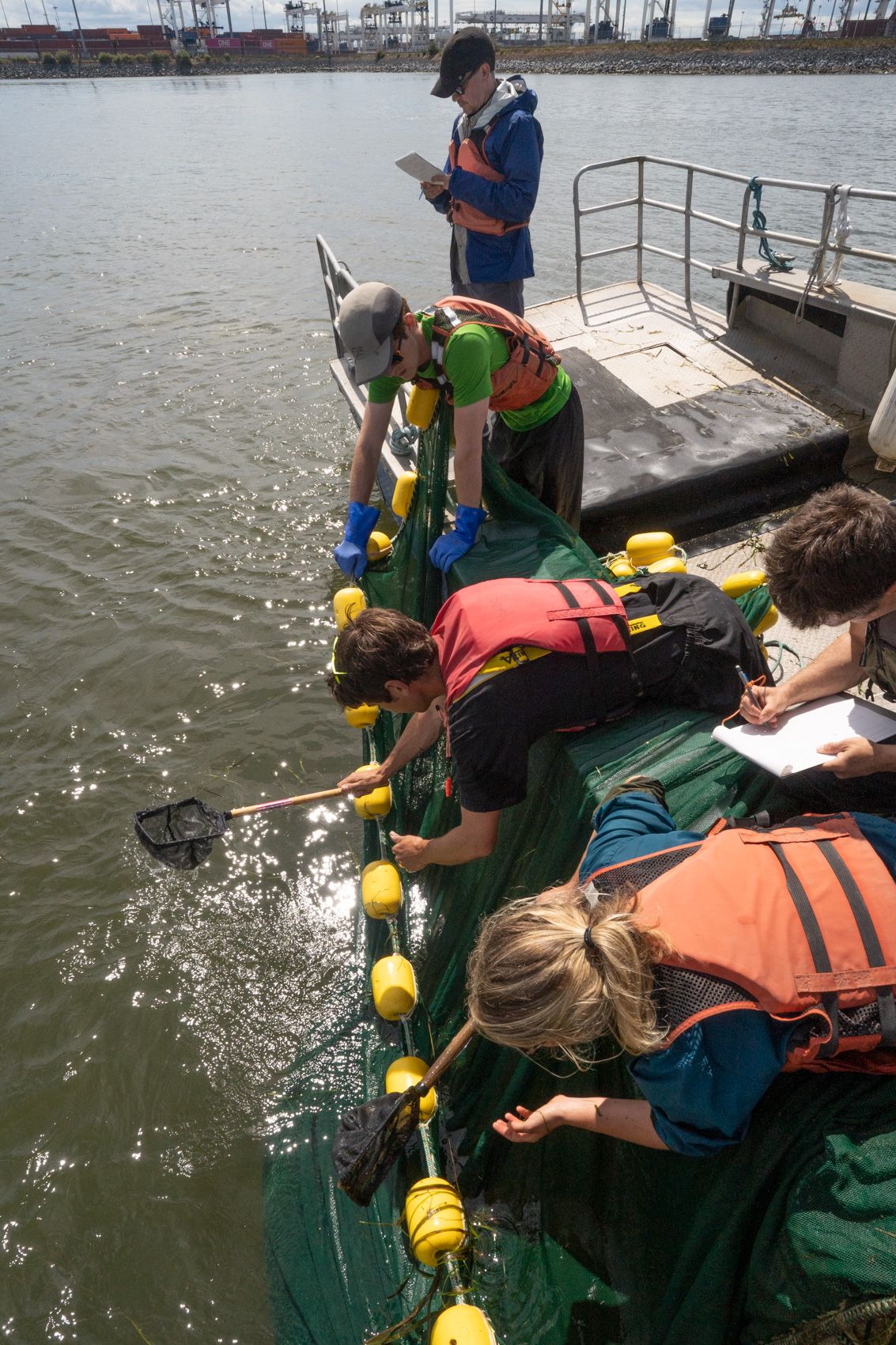
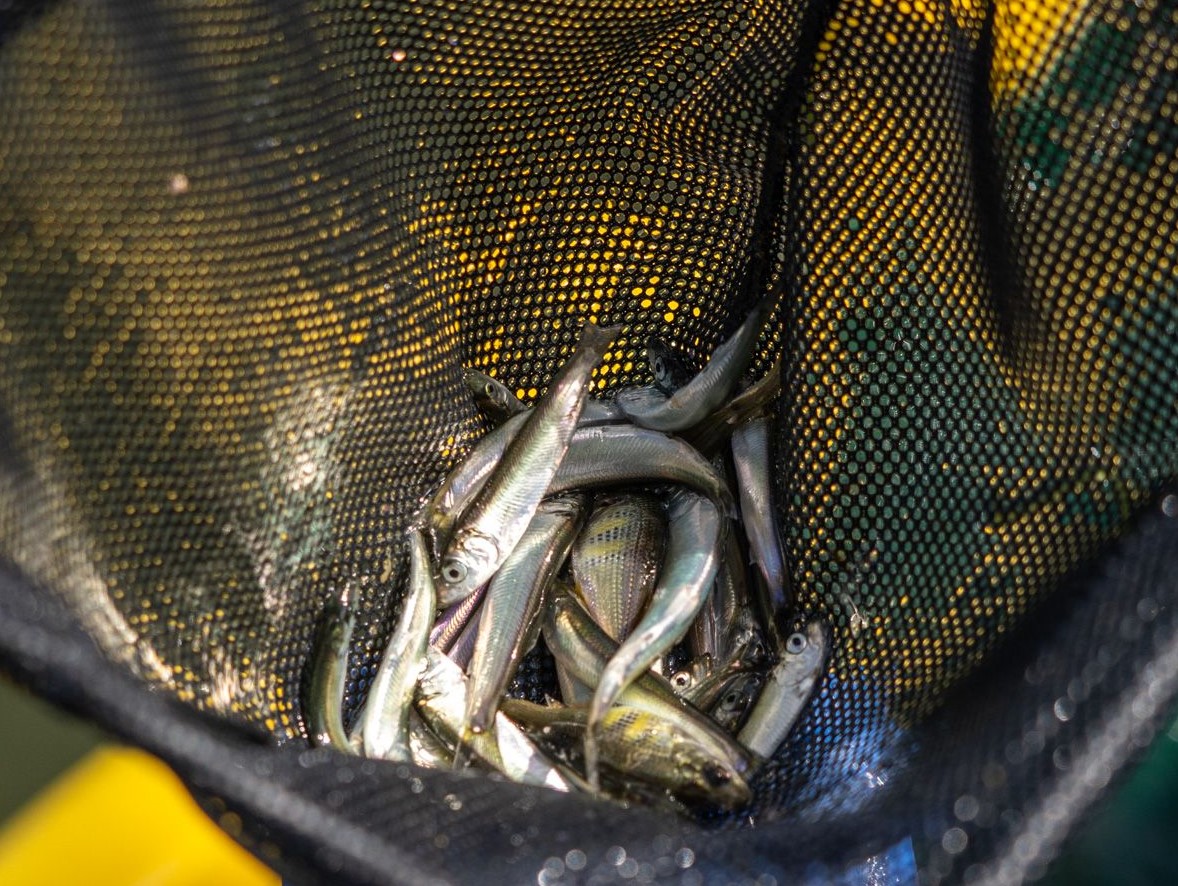
Over the course of the afternoon on the estuary, we net about 15 different species of sea life including herring, sand lance, gunnels (an eel-like fish), Dungeness crabs, steelhead and even a 14-centimetre sockeye, the latter which leaves the crew of young scientists scratching their heads.
If there is a takeaway from his research to date, Scott says it’s that certain Fraser Chinook salmon rely on this part of the estuary, as they move from freshwater marshes into the saltwater eelgrass meadows that grow near the Deltaport site at Roberts Bank.
“This project would be a major setback, removing a large amount of habitat and further altering their migration routes.”
What will be required to construct the new island, covering about 130-hectares of seabed in the midst of the Fraser estuary, with a wharf capable of serving the largest container ships on earth, at a depth of over 17 metres? First the seabed will be dredged of loose silt and sediments. The basic building block of the new wharf will be a concrete structure called a “caisson” — a concrete block about 42 metres long, 18 metres wide, standing as tall as a nine-story building. Thirty of these caissons will be prefabricated on land and towed to the project site, to be sunk and piled.
Building the project will require 17 million cubic metres of aggregate — everything from locally-quarried rock and gravel to sand dredged from the estuary bottom, according to the Roberts Bank Terminal 2 Environmental Impact Statement.
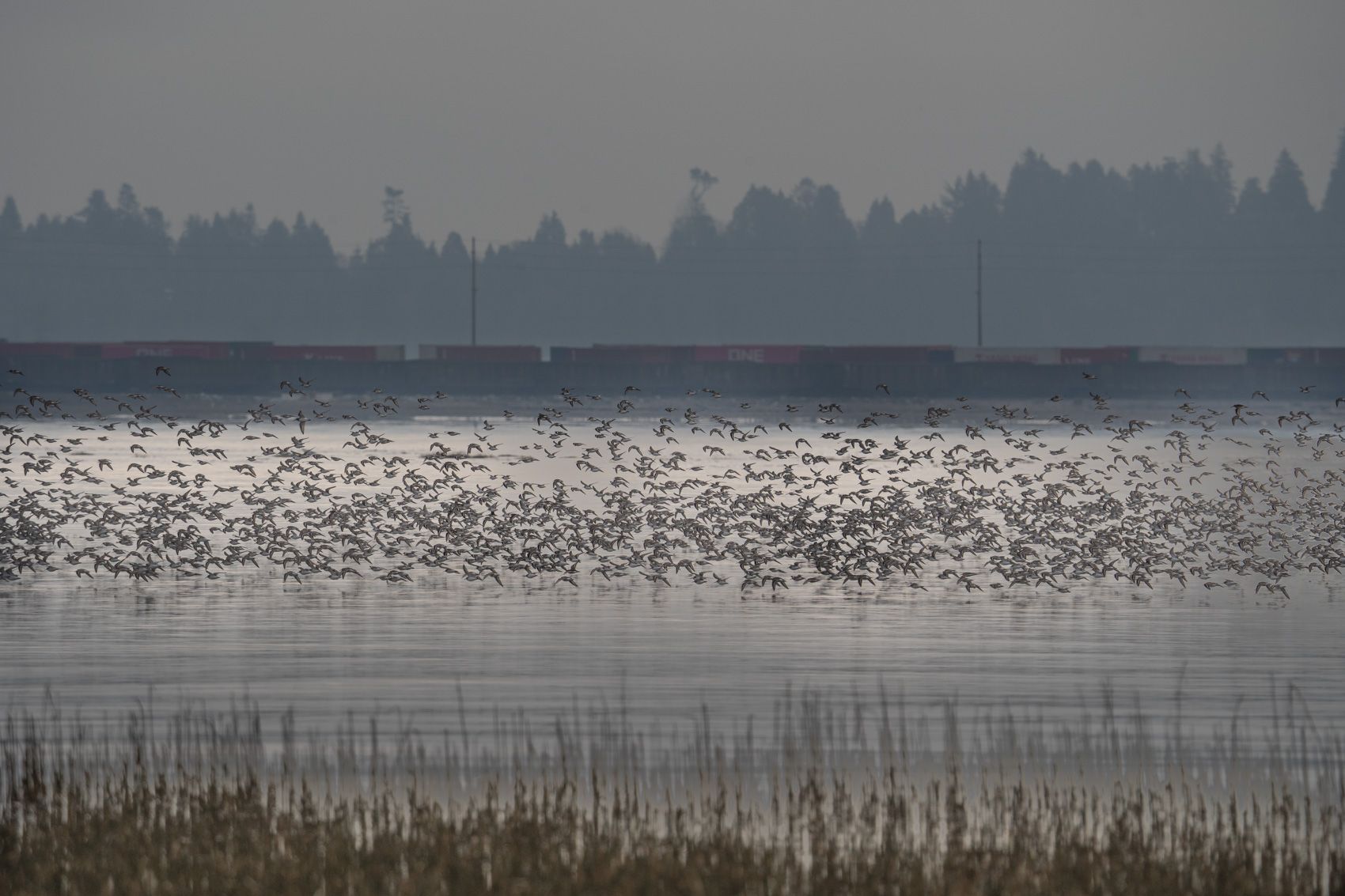
In recent months, the Port Authority has engaged in an aggressive publicity campaign, including TV ads, positioning the T2 expansion as an important stimulus for B.C.’s economic recovery from COVID.
"We’re well positioned to be a big part of the economic recovery,” Robin Silvester, the port’s chief executive officer, told the Globe and Mail in May. “For an economy emerging from a significant pandemic-induced recession, that would be a big economic boost.”
It’s a fact that building Terminal 2 will be a massive, complex and labour intensive. Critics say the cost has been rising steadily upwards since the project was first conceived in the early 2000s: from $2 billion to about $3.5 billion at present.
In an interview with The Tyee, Duncan Wilson, vice-president of environment, community and government relations at the Vancouver Fraser Port Authority, confirmed the rationale for building the project is based on Port Authority forecasts showing traffic on Canada’s west coast will double between 2014 to 2030, a prediction Wilson does not think that COVID will affect.
He reports year-to-date declines in shipping volume of just 7.7 per cent, which is much less than the nearly 15 per cent decline during the 2008–09 recession. “The forecasts are showing that we’re already expecting some bounce back in the next couple of months, so we’re expecting the volumes to come back.”
Doron Grosman is president and CEO of GCT Global Container Terminals, which operates both Deltaport and the Vanterm terminal on Burrard Inlet, on land leased from the Port Authority. In an interview he said his company has its own port expansion solution that will provide roughly the same container capacity as T2 at half the cost, without the environmental destruction of building a new island or widened causeway. His group proposes to expand the existing Deltaport incrementally as needed, instead of building out a massive new facility in anticipation of container demand decades in the future.
Grosman cites their own internal research showing that additional container capacity in B.C. won’t be needed until the 2030s at the earliest.
More than a year ago GCT’s proposed expansion project — called the Canadian Deltaport Project — was rejected by the Port Authority, which has prompted GCT to sue the Port Authority in federal court, with a judicial review expected to be held early next year.
“No government agency is going to support [T2] until the judicial review has been heard,” says Grossman.
And while they wait for the court outcome, GCT is forging ahead, with a plan to have their “initial project description” in the hands of the regulators in its final form before the end of the summer.
In an ongoing war of words, GCT continues to criticize the escalating cost in taxpayer dollars as a weakness of the Port Authority’s plan, using slick videos on social media and through its advocacy website BetterDeltaport.ca.
The Port Authority’s Wilson is adamant that the cost of the expansion would not ultimately be borne by taxpayers. The business model of the expansion is this: the port authority leads the construction and stickhandles regulatory project hurdles, then will lease the new facility to a private terminal operator, who pays the port back over a period of a long-term lease, recovering the initial investment. He would not divulge the full cost of T2, other than to say the new island terminal will cost $2 billion.
On its website, the Port Authority estimates the project will eventually create almost 12,500 full-time jobs, adding $1.2 billion GDP each year to the economy.
Grosman says the positioning of T2 as some kind of badly needed economic boost to lift us out of the COVID doldrums is hogwash.
“They’re trying to get public opinion, and we are too, but neither of our projects will have a shovel in the ground for at least three years,” he said. “And we can’t wait three years to get British Columbians back to work.”
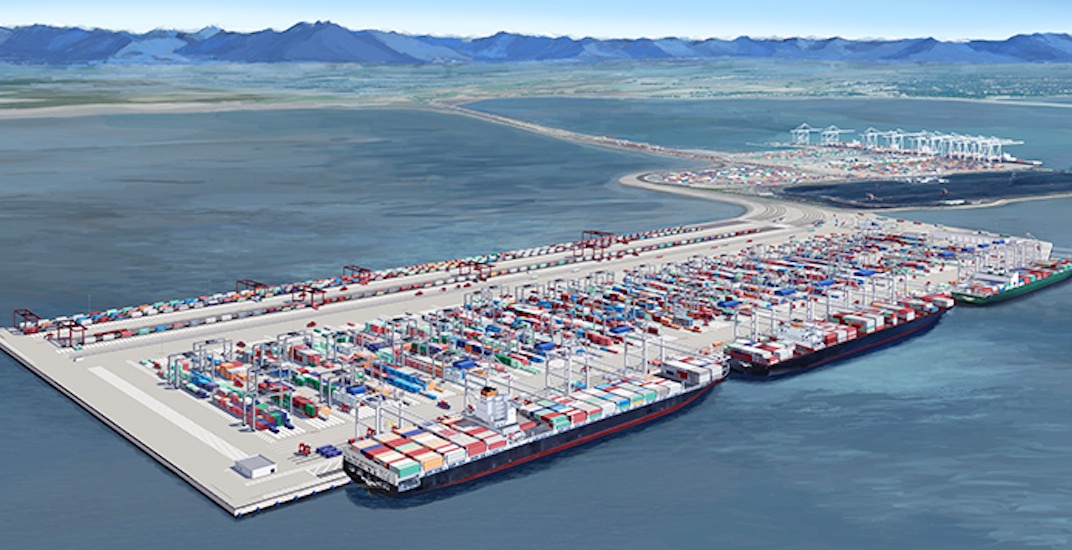
Back out at Roberts Bank, there are at least six red buoys on the seabed over the proposed T2 footprint, marking crab traps waiting to be harvested by local First Nations fishermen.
Our captain on this day is Riley Baird, who spends much of his summer fishing for Dungeness crab in this area, a typical crabbing season lasting from May to end of July. He is piloting the Bella Rosa instead of fishing today, on hire to Raincoast. He grimaces at the mention of the island being built here. “It’s going to suck,” he says. “This is where the best crabbing is.”
The Tsawwassen First Nation did not respond to calls for this story, and Wilson would not confirm or deny if an impact benefit agreement has been finalized to date.
Delta Mayor George Harvie also did not return calls, but on the day we were out on the water, the City of Delta passed a motion to urge Prime Minister Justin Trudeau and the federal environment minister to reject Terminal 2. One reason it cited was the failure to consider the GCT project as a “potential alternative.”
Most of their concerns stem from the federal government’s own review panel findings noted above, including impacts to endangered local killer whales, which the federal government has a legal duty to protect.
And as the federal decision approaches, Raincoast plans to continue gathering data on how Chinook salmon use the areas most affected by the proposed expansion. Misty MacDuffee, a biologist and salmon expert with Raincoast, who is working with Scott on the Chinook sampling project, says the new island should be rejected outright, in spite of the economic benefits it will provide.
The way she talks about Terminal 2 raises a deeper question posed by the pandemic. Should we double down on previous expectations of economic growth tied to globalized trade, or should we protect what underpins our regional self-reliance?
“The best stimulus project, if we are talking about COVID,” she says, “is to invest in the resilience of our ecosystems and the protection of resources and species we already have, rather than undermine them with a project like this.” ![]()
Read more: Local Economy, Environment


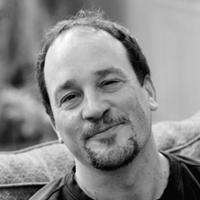
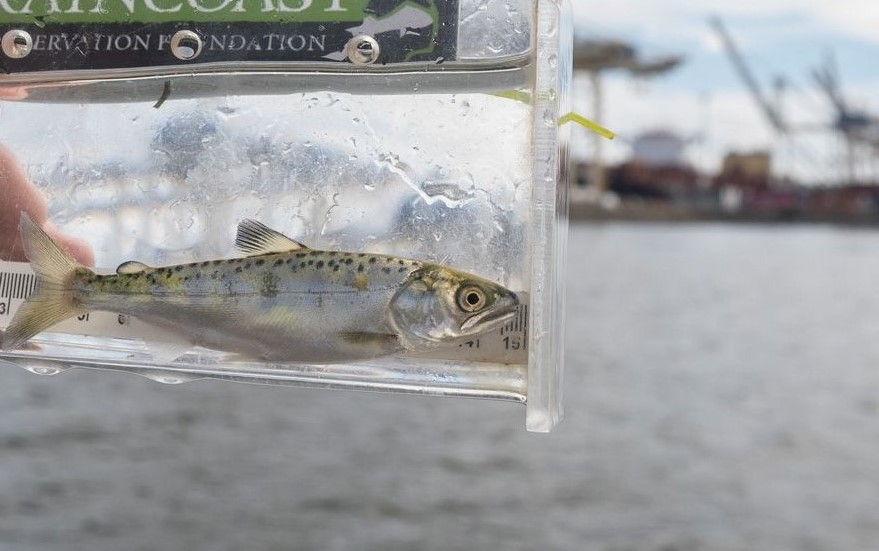












Tyee Commenting Guidelines
Comments that violate guidelines risk being deleted, and violations may result in a temporary or permanent user ban. Maintain the spirit of good conversation to stay in the discussion.
*Please note The Tyee is not a forum for spreading misinformation about COVID-19, denying its existence or minimizing its risk to public health.
Do:
Do not: